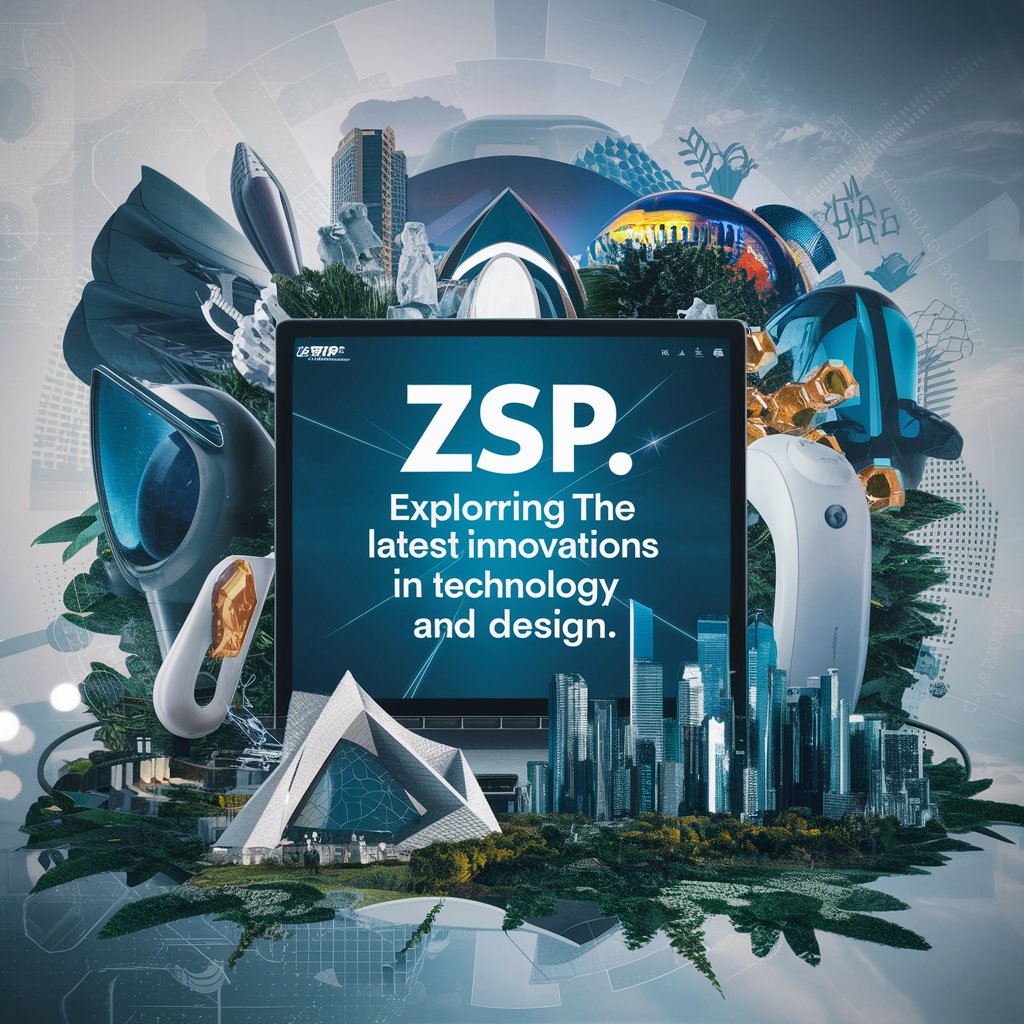Innovations
ZSP: Exploring the Latest Innovations in Technology and Design

To the cutting-edge world of ZSP – Zero Signal Processing, where technology and design seamlessly merge to revolutionize the way we interact with the digital realm. Imagine a future where signals are not just processed but eliminated entirely, paving the way for unparalleled efficiency and innovation. In this blog post, we will dive deep into the realm of ZSP, exploring its benefits, applications, challenges, and exciting possibilities that lie ahead. Join us on this thrilling journey as we unravel the mysteries behind this game-changing technology!
The Benefits of ZSP in Technology and Design
Zero Signal Processing (ZSP) brings a myriad of benefits to the world of technology and design. By eliminating unnecessary signal processing stages, ZSP enhances efficiency and reduces energy consumption in devices and systems. This results in faster processing speeds, improved performance, and extended battery life for electronics.
In design, ZSP allows for sleeker product designs with fewer components, leading to more compact and lightweight devices. The streamlined approach also opens up new possibilities for innovative form factors and user experiences. Additionally, by cutting down on signal interference and noise, ZSP helps deliver clearer audio quality in multimedia applications.
The integration of ZSP into technology and design not only boosts functionality but also paves the way for sustainable practices through reduced power consumption and materials usage.
Examples of ZSP in Action
ZSP, or Zero Signal Processing, has been making waves in the technology and design world with its innovative approach to problem-solving. One remarkable example of ZSP in action is in the field of smart homes. By utilizing ZSP algorithms, devices can communicate efficiently without the need for continuous data processing, leading to streamlined operations and enhanced user experience.
Another exciting application of ZSP can be seen in healthcare technology. Medical devices equipped with ZSP capabilities can collect and analyze patient data more effectively, enabling quicker diagnoses and personalized treatment plans. This not only improves patient outcomes but also enhances overall healthcare efficiency.
Moreover, the automotive industry has embraced ZSP to develop autonomous vehicles that rely on minimal external input for decision-making processes. These self-driving cars leverage advanced sensor technologies combined with ZSP algorithms to navigate complex road scenarios safely.
In essence, examples of ZSP in action highlight its transformative impact across various sectors, paving the way for a future where intelligent systems operate seamlessly with minimal signal processing requirements.
Challenges and Limitations of ZSP
As with any cutting-edge technology, Zero Signal Processing (ZSP) comes with its own set of challenges and limitations. One key challenge is the complexity of implementing ZSP across various devices and systems seamlessly. It requires a high level of expertise and resources to ensure optimal performance without compromising other functionalities.
Another limitation is the potential for increased power consumption when using ZSP algorithms extensively. Balancing efficiency with computational demands remains a crucial aspect that developers need to address continually.
Moreover, compatibility issues may arise when integrating ZSP into existing technologies or platforms. Ensuring seamless integration without causing disruptions or conflicts can be a significant hurdle for organizations looking to adopt ZSP solutions.
Despite these challenges, ongoing research and development efforts are focused on overcoming these limitations to fully harness the benefits of ZSP in enhancing technological innovation and design.
Future Possibilities for ZSP
The future possibilities for ZSP are vast and promising. As technology continues to advance, the potential applications of Zero Signal Processing are expanding rapidly. Imagine a world where devices can operate with ultra-low power consumption, leading to increased efficiency and longer battery life.
In the field of design, ZSP opens up new avenues for creating sleeker, more streamlined products that seamlessly integrate into our lives. From smart homes to wearable tech, the possibilities for innovation are endless.
One exciting prospect is the use of ZSP in medical devices, revolutionizing healthcare by enabling real-time monitoring and analysis without bulky equipment. This could lead to early detection of health issues and personalized treatment plans tailored to individual needs.
Furthermore, incorporating ZSP into artificial intelligence systems could enhance their performance by reducing latency and improving response times. This could have significant implications for industries ranging from autonomous vehicles to financial services.
The future of Zero Signal Processing holds immense potential for reshaping technology and design across various sectors.
How to Incorporate ZSP into Your Business or Projects
Are you looking to enhance your business or project with cutting-edge technology and design? Incorporating ZSP (Zero Signal Processing) could be the game-changer you need. To start, assess your current processes and identify areas where ZSP can streamline operations and boost efficiency. Collaborate with tech experts to customize ZSP solutions tailored to your specific needs.
Training your team on how to leverage ZSP tools effectively is crucial for successful implementation. Encourage a culture of innovation within your organization that embraces experimentation and continuous improvement through ZSP integration. Monitor progress closely and gather feedback from stakeholders to make necessary adjustments along the way.
By incorporating ZSP into your business or projects, you’re not just adopting a trend; you’re embracing a mindset that prioritizes optimization and innovation. Stay ahead of the curve by harnessing the power of Zero Signal Processing in everything you do!
Core Technologies and Innovations
In the realm of Zero Signal Processing (ZSP), core technologies and innovations play a pivotal role in shaping the landscape of technology and design. At its essence, ZSP involves harnessing the power of minimal processing to achieve optimal results.
One key technology driving ZSP forward is machine learning algorithms that enable devices to learn from data and make decisions without human intervention. This level of automation allows for faster processing speeds and more efficient operations.
Another fundamental innovation within ZSP is the integration of advanced sensor technologies. These sensors can collect real-time data, enabling devices to adapt and respond instantaneously to changes in their environment.
Furthermore, advancements in hardware design have facilitated the development of more compact and energy-efficient devices that are capable of delivering high performance while consuming minimal power.
By continuously pushing the boundaries of technological innovation, ZSP paves the way for a future where efficiency, speed, and sustainability converge seamlessly in our everyday lives.
Key Projects and Developments
Key Projects and Developments in Zero Signal Processing (ZSP) showcase the cutting-edge applications and advancements pushing the boundaries of technology and design. From innovative wearable devices enhancing user experience to smart home automation systems streamlining daily tasks, ZSP is revolutionizing how we interact with our surroundings.
One noteworthy project involves utilizing ZSP in autonomous vehicles, optimizing sensor data processing for enhanced safety and efficiency on the roads. Another exciting development is seen in healthcare technology, where ZSP is being leveraged to improve patient monitoring systems, leading to more accurate diagnostics and personalized treatment plans.
Moreover, key collaborations between tech giants and startups are driving forward groundbreaking projects integrating ZSP into various industries like never before. These partnerships are fostering a culture of innovation that promises a future filled with endless possibilities for customized solutions tailored to individual needs.
Market Position and Industry Impact
Market Position and Industry Impact:
ZSP has been making waves in the tech and design world, revolutionizing how signals are processed. Its disruptive approach has positioned it as a game-changer in various sectors, from telecommunications to consumer electronics.
The industry impact of ZSP is profound, redefining traditional signal processing methods and paving the way for more efficient and innovative solutions. Companies embracing ZSP technology are gaining a competitive edge by offering cutting-edge products that meet the demands of today’s fast-paced market.
With its ability to streamline processes and enhance performance, ZSP is reshaping industries across the board. From improving communication networks to optimizing product design, its influence is felt far and wide.
As businesses continue to adopt ZSP into their operations, we can expect to see even greater advancements in technology and design. The market position of companies leveraging this innovation will only strengthen as they stay ahead of the curve in meeting consumer needs and expectations.
Collaborations and Partnerships
Collaborations and partnerships play a pivotal role in driving innovation within the realm of ZSP. By joining forces with like-minded individuals or organizations, new ideas can be cultivated and brought to life. These collaborations often result in groundbreaking technological advancements that push the boundaries of what is possible.
When experts from different fields come together, they bring diverse perspectives and skill sets to the table. This synergy leads to the development of solutions that are not only innovative but also effective in addressing complex challenges. Through strategic partnerships, companies can leverage each other’s strengths to create products or services that stand out in the market.
In the world of ZSP, collaborations extend beyond traditional boundaries, fostering cross-industry alliances that spark creativity and drive progress. Whether it’s merging technology with design principles or integrating sustainability practices into product development, these partnerships pave the way for a more interconnected and sustainable future.
Sustainability and Environmental Initiatives
In the realm of technology and design, sustainability and environmental initiatives play a crucial role in shaping a better future. Companies embracing ZSP are at the forefront of incorporating eco-friendly practices into their products and processes. By reducing energy consumption and waste generation, they are actively contributing to a greener planet.
From utilizing recyclable materials in manufacturing to designing energy-efficient devices, ZSP has opened up new avenues for sustainable innovation. These initiatives not only benefit the environment but also resonate with consumers who prioritize ethical and environmentally conscious brands.
By promoting sustainability through ZSP, businesses can differentiate themselves in the market while making a positive impact on the world around us. As more companies adopt these principles, we move closer to creating a more sustainable future for generations to come.
Future Prospects and Vision
The future prospects and vision of ZSP are limitless, with endless possibilities waiting to be explored. As technology continues to advance at a rapid pace, the potential for incorporating Zero Signal Processing into various industries is immense.
In the coming years, we can expect to see ZSP revolutionize how data is processed and utilized across different sectors. From enhancing efficiency in manufacturing processes to optimizing performance in electronic devices, the applications of ZSP are diverse and far-reaching.
As businesses strive to stay ahead of the curve and remain competitive in a fast-evolving digital landscape, embracing it will be key to driving innovation and achieving sustainable growth. By harnessing the power of zero signal processing, organizations can unlock new opportunities for improved productivity and enhanced user experiences.
Looking towards the horizon, the vision for it involves creating smarter systems that operate more efficiently while minimizing energy consumption. With a focus on sustainability and environmental responsibility, ZSP aims to pave the way for a greener future where technology works hand in hand with nature.
Customer Testimonials and Case Studies
Customer testimonials and case studies are powerful tools that showcase the real-world impact of ZSP technology. Hearing directly from satisfied clients can provide valuable insights into how it has transformed their businesses.
One customer shared how implementing it in their design process significantly improved efficiency, leading to cost savings and faster time-to-market for their products. Another client highlighted how it revolutionized their technology by enhancing performance and reducing energy consumption.
Case studies offer detailed narratives of successful projects where it played a pivotal role in achieving remarkable outcomes. From optimizing data processing speed to enhancing user experience, these stories illustrate the versatility and effectiveness of zero signal processing.
The authentic feedback from customers underscores the tangible benefits of integrating ZSP into various industries, fostering innovation, and driving competitive advantage.
Conclusion: Embracing the Power of Zero Signal Processing
As we journey through the realm of technology and design, it emerges as a beacon of innovation. It challenges traditional paradigms, pushing boundaries to new horizons. Embracing Zero Signal Processing is not just about adopting a new trend; it’s about revolutionizing industries and redefining possibilities.
In a world where signals reign supreme, it offers a fresh perspective – one that eliminates noise and enhances clarity. It opens doors to unparalleled efficiency and creativity, paving the way for groundbreaking solutions in various fields.
By harnessing the power of it, businesses can unlock hidden potentials and stay ahead in competitive landscapes. It’s not merely an option but a strategic imperative for those striving for excellence.
The future holds endless opportunities for those willing to embrace this transformative approach. With it at the helm, the path to progress becomes clearer than ever before. Join the movement towards a signal-free future today!
FAQs
Q: What is the significance of ZSP in technology and design?
A: It revolutionizes traditional signal processing by eliminating the need for complex algorithms. Leading to faster and more efficient systems in various industries.
Q: How can businesses incorporate ZSP into their projects?
A: Businesses can integrate it by partnering with innovative tech companies or investing in research. And development to implement zero signal processing solutions tailored to their specific needs.
Q: What are some key projects showcasing the power of ZSP?
A: From cutting-edge medical devices to advanced autonomous vehicles. Numerous groundbreaking projects demonstrate how it enhances performance and drives innovation across different sectors.
Embracing the Power of Zero Signal Processing
As we delve deeper into the realm of technology and design. It becomes evident that Zero Signal Processing (ZSP) stands at the forefront of innovation. Its ability to streamline processes, enhance efficiency. And unlock new possibilities marks a significant shift in how we approach complex challenges. By embracing it, businesses can not only stay ahead of the curve but also pave the way for a future where creativity knows no bounds. Let us embark on this journey together towards a world powered by limitless potential.
FOR FURTHER INFORMATION VISIT:http://worldmagzines.com
-

 Tech2 months ago
Tech2 months agoGoogles 25e Verjaardag: The Past, Present and Future of the Internet Giant
-

 Life Style2 months ago
Life Style2 months agoLuv.Trise: Elevate Your Heartbeat
-

 Life Style2 months ago
Life Style2 months agoSSoap2day Alternatives: Where to Watch Movies and TV Shows Online
-

 Entertainment2 months ago
Entertainment2 months agoHalf Of A 1990s-2000s Rock Duo With Six Grammys
-

 Tech2 months ago
Tech2 months agoYTMP3: YouTube to MP3 Converter
-

 Technology2 months ago
Technology2 months agoWhat is 2023-1954 Journey?
-

 Entertainment2 months ago
Entertainment2 months agoStreameast vs. Other Streaming Services: Which One Comes Out on Top?
-

 Games1 month ago
Games1 month agoFutemax: The Ultimate Streaming Platform for Soccer Fans in 2024
